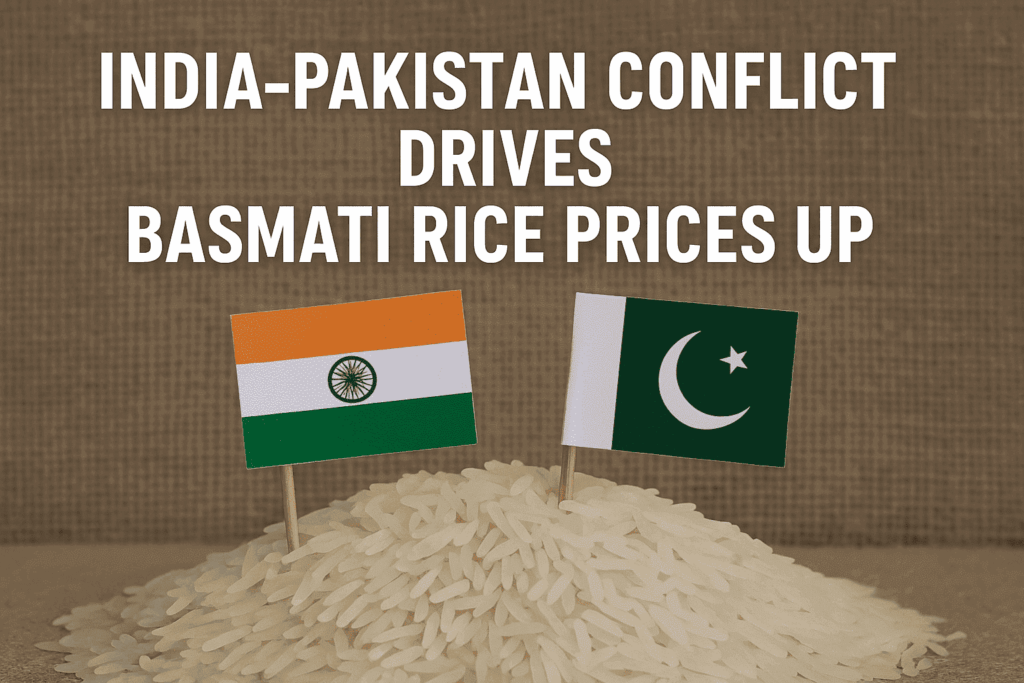
As geopolitical tensions rise between India and Pakistan, Basmati rice prices have experienced a significant surge, climbing by up to 18% in just two months. Basmati rice prices have increased from Rs 55 to Rs 65 per kilogram, a trend expected to impact both domestic and international markets.
Geopolitical Factors Driving Price Increase
There has been an impact of the recent escalation in the India-Pakistan conflict on global rice markets. In addition, despite the uncertainty surrounding the direct impact of the conflict on rice supply chains, the market is reacting to heightened uncertainty surrounding trade between the two nations.
Both India and Pakistan are major exporters of rice, with India being the world’s largest exporter of Basmati rice. Any disruptions in trade routes or the imposition of new tariffs could further strain the supply chain, causing prices to rise globally. In addition, for Southeast Asian nations that rely on these rice exports, such as Malaysia, Indonesia, and Singapore, higher prices may result in higher food costs and tighter supplies.
Policy Changes and Government Interventions
In addition to the geopolitical tension, the Indian government has introduced several policy changes that are contributing to the price surge. Most notably, the removal of the minimum export price for Basmati rice has made Indian rice more competitive on the global market. This policy shift, combined with a boost in rice allocations for ethanol production, has encouraged more rice exports, contributing to the rising price.
Moreover, erratic weather conditions in key rice-growing regions have further impacted crop yields. Rising input costs, such as fuel and fertilizers, combined with transport challenges, are making it harder for rice exporters to maintain stable pricing. However, these external factors continue to fuel market volatility, and Indian rice prices are expected to remain elevated in the near term as a result.
ALSO READ: India Imposes 20% Export Duty on Parboiled and Milled Rice – What You Need to Know

Exporters and Importers: What’s Next?
For rice exporters, this surge in prices presents both challenges and opportunities. While higher prices may lead to increased revenue, the volatile global market could complicate long-term contracts. As countries like Pakistan increase their rice exports to meet demand, Indian exporters are facing pressure to maintain their market share in the face of these new dynamics.
On the other hand, consumers and importers in Southeast Asia, particularly in countries like Malaysia and Singapore, could feel the pinch. There have already been statements from Malaysia’s Agriculture Ministry regarding the potential risks to rice supply and the need for alternative sources if the conflict escalates further.
How Rice Exporters Can Prepare?
For exporters in India, this is an important moment to diversify supply chains and explore new markets. The impact of tensions on trade will require proactive strategies to mitigate risk. These include securing long-term contracts and exploring alternative transportation routes.
At Shah Enterprises, we are committed to navigating these challenges by ensuring the consistent supply of high-quality Basmati rice to meet both domestic and international demand. With our expansive network and extensive experience in international markets, we continue to adapt to these changing circumstances to provide reliable solutions for our clients.
Conclusion
The rising price of Basmati rice and the potential for further volatility in the coming months call for careful consideration from both exporters and importers. Further, understanding the interplay between geopolitics, government policies, and climate change is essential for adapting to this rapidly evolving market.
For rice exporters looking to stay competitive, it is essential to stay informed about global trade developments and be ready to adjust strategies as needed. As the situation evolves, staying ahead of market trends will help mitigate risks and capitalize on opportunities.
ALSO READ: India Introduces New Tariff Rule for Rice Exports From May 1, 2025

